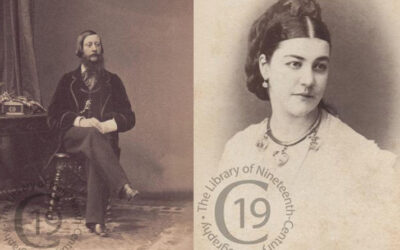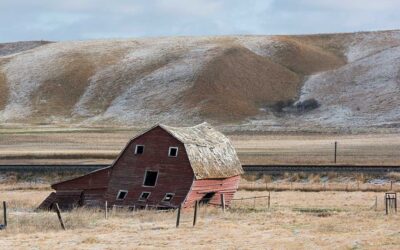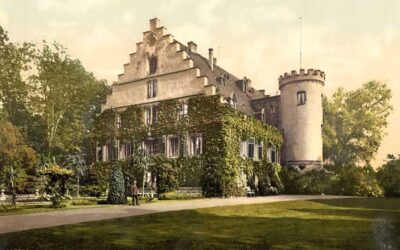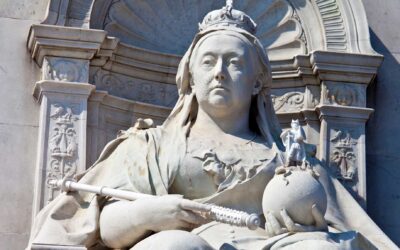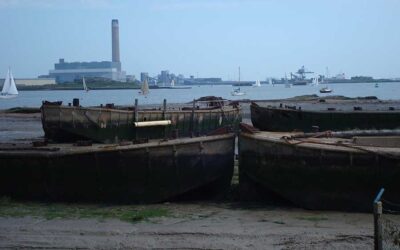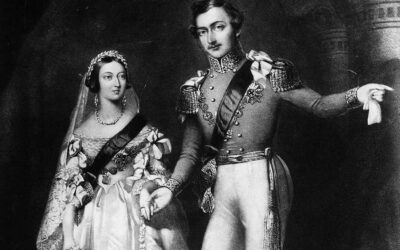The Victorian Christmas
“Already this dear Festival returned again, & this year with true Xmas weather, snow on the ground & sharp frost. Albert & the Princes out shooting, but Louis preferred remaining with Alice. Walked down with them to the skating pond, where we found the other girls …
We came home after 4, then began the arranging of the present tables, which was most bewildering, but however at last with dear Albert’s great indefatigability, we succeeded …
Everyone seemed delighted with their present. I got charming & beautiful things. …
All the dear Children worked me something, also Mama. As usual, such a merry happy night with all the Children.”
QUEEN VICTORIA’S DIARY, CHRISTMAS EVE, 1860
The Victorian Christmas
The cosy Dickensian Christmas traditionally referred to in Queen Victoria’s diary for Christmas Eve 1860, and which we have come to know and love in Britain, was in great part popularized by Victoria and Albert after their marriage in 1840. During the 21 years that followed they did much to set their own particular stamp on how the festival is celebrated in this country.
Christmas with the Royal Family at Windsor
It all began with that first magical image of the happy Royal Family gathered round the tree – in this case one of several decorated trees that Victoria and Albert installed each year at Windsor. But note that the tree illustrated here was in fact an artificial one, as you can see from the uniformity of size and the symmetry of its bows. The royal family, from the outset, used a mix of real and artificial trees. The chandeliers at Windsor had to be taken down to accommodate the larger trees, which were securely suspended from the ceiling, their bases resting on tables.
The image, published in the Illustrated London News at Christmas 1848 and widely circulated thereafter, set in stone our popular perception of Christmas as a cosy family affair promoted by the Christian religion, but it had originally begun as a pagan winter festival.
The Pagan Winter Festival
Fir trees had been used by both the Romans and the Vikings in their own ancient rituals. They first became part of the Christian celebration in the Rhineland during the Middle Ages, when they were used to represent the Paradise Tree in the story of Genesis in plays about Adam and Eve. Originally performed on December 24, these plays featured a tree decorated with sweetmeats to represent the apples of the Garden of Eden. In this form, the tree became part of a wider Christian celebration across Northern Europe for many centuries. In Britain, however, Oliver Cromwell’s parliamentary party disapproved of the celebration of Christmas after they were victorious in the English Civil War as idolatrous and papist. Although the celebration of Christmas returned with the restoration of Charles II, it did not enjoy a real revival until Victoria’s day.
Because Prince Albert did so much to encourage the use of traditional German Christmas decorations, most notably the tree itself, it has been widely assumed that he ‘invented’ Christmas. But the German celebration of the festival had probably been brought to England with the accession to the throne of the Hanoverians in the late seventeenth century, although it was George III’s wife, Charlotte of Mecklenburg-Strelitz who first set up branches of yew tree decorated with candles and sweetmeats at Windsor in 1800. Until the arrival of Albert, the British celebration of Christmas, such as it was, had been kept going by immigrant German merchants had begun importing Christmas trees to Manchester in the early 1820s for their own use.
Christmas Trees at the British Court
The setting up of a Christmas tree had however continued at court, under the influence of another German, Queen Adelaide of Saxe-Coburg-Meinigen, wife of Victoria’s uncle, William IV. As a young girl, Princess Victoria recorded her own pleasure at the Christmas tree she had at her home at Kensington Palace, again no doubt under the influence of her mother, the Duchess of Kent, another member of the Saxe-Coburg family. After Victoria’s marriage to Prince Albert in February 1840 and the birth of their first two children in quick succession, Albert became nostalgic for the Christmases he had enjoyed at his home at Coburg near the Thuringian Forest. He suggested that he and Victoria adopt the German custom of setting up a tree. A suitable fir was chopped down in Windsor Great Park for the purpose and decorated with wax tapers, ribbons, and sugarplums. The royal children took such delight, as did the Queen, in the warm sense of family togetherness that Christmas at Windsor engendered, that during her marriage Victoria would treasure ‘this dear happy time’.
Eventually Victoria and Albert would also set up trees for each other in their own private sitting rooms, as well as in those of the Duchess of Kent and other members of the royal household. Some trees were imported specially from Germany. These would be laden with all kinds of trinkets, toys, gilded fruit and nuts, as well as the first manufactured tree decorations – hand-blown glass baubles and icicles – also German imports, as was the Nuremberg angel, without which no Christmas tree was complete. Once given the seal of approval by Victoria and Albert, a decorated tree became the essential element of every English family Christmas, no matter how humble.
Throughout the 1840s Prince Albert promoted the widespread use of Christmas trees in Britain, himself presenting them to schools and army barracks across the country. Whilst most of the other modern-day trappings of Christmas – such as crackers from France, the popularisation of carols (again, French in origin) and the food eaten, were drawn from different cultures – Victoria herself did introduce one English tradition. She began adding coins, in her case sovereigns, to the Christmas pudding, apparently did as a gesture of thanks to her cook. The royal family also took particular pleasure in their own Christmas dinner. As well as opting for turkey (first introduced in the reign of Henry VIII but not popularized at Christmas until the 1800s by the Prince Regent), they also enjoyed joints of beef from cattle bred at Prince Albert’s own model farm in Windsor Great Park.
As a young girl, Princess Victoria had taken great delight in another seasonal British tradition – the pantomime, which had originated with seasonal pageants based on the Italian commedia dell’arte, introduced by Edward IV in the late fifteenth century. In particular, she had greatly enjoyed Harlequin and Jack Frost at Drury Lane in January 1839 and took the royal children regularly to the pantomimes staged at the Royal Lyceum at Christmas time during the 1840s and 1850s.
The Dickensian Version of Christmas
The ‘invention’ of the familiar, chintzy Victorian Christmas that we all know today was of course not entirely the work of Victoria and Albert. Although the royal couple popularized its image as a family event, it was really the writer Charles Dickens who captured that intangible element – the Victorian Christmas spirit – in his 1843 story, A Christmas Carol. He had in fact already had a stab at the genre as early as 1835, when he had described a family Christmas dinner in heart-warming tones in one of his Sketches by Boz. A Christmas Carol was itself a reworking of a celebration of Christmas at Dingley Dell that Dickens had described in his first novel The Pickwick Papers (1836). The visualization of the Spirit of Christmas by illustrator John Leech in 1843 became an equally important, totemic contribution to the story’s popularity.
The Victorian sense of Christmas as a ‘season of good will to all men’ would naturally enough be translated into the self-comforting belief, held by many in 19th century Britain, that the ritual acts of charity they performed at this time – such as in Scrooge’s case the donation of a fat turkey to the impoverished Scratchits – would secure them their place in heaven. Acts of royal benevolence in Britain’s workhouses and almshouses also became a tradition: in December 1842, according to The Times, Queen Victoria ordered that ‘every poor adult in Windsor town’ be given ‘4 lbs of beef , 2 lbs of bread, 1 lb of plum pudding, a peck of potatoes and two pints of ale’, a tradition repeated annually thereafter.
Surprisingly, Christmas in the 1840s brought with it precisely the same problems of supply and demand and transportation overload as it does now. Complaints were made about the higher seasonal prices for fruit and vegetables at Covent Garden, and of trains running late because of greater passenger numbers. On 28 December 1841 The Times carried a hilarious description of how the Yarmouth coach had been so over laden with baskets, and hampers and barrels of all sizes and shapes’ that whilst going along Lombard Street its springs had given way and it had crashed to the ground.
Every inch of space both inside and outside the vehicle had been stuffed and festooned, with ‘turkeys, fish, hares, rabbits, pheasants, partridges and oyster barrels’. Meanwhile, the criminal fraternity found novel ways of exploiting the increased demand for meat during the season; one alert customs & excise man at London’s St Katherine’s docks became suspicious in December 1841 of some unusually heavy geese that arrived on the dock. On opening them up he discovered each contained a ‘bottle of overproof whisky’. ‘A number of fine young sucking pigs’ were also similarly discovered to contain Scotch whisky and ‘no less than 30 Dutch turkeys’ were found to have been ‘stuffed with Holland gin’.
There was however, in painful contrast to the normally happy celebrations, one notable experience of the Victorian Christmas – endured by British troops a long way from home during the Crimean War against Russia – that cast a long pall and stuck in the public’s memory.
Christmas in Crimea during the War of 1854–6
The Crimean plain in winter is a bare, windswept and utterly unforgiving place. For the British troops who had marched off to war so optimistically early in 1854, the prospect of Christmas in the trenches before Sevastopol was a desperately bleak and cheerless one.
Those who had survived the three terrible battles of Alma, Balaclava and Inkerman that autumn, or who had not by now succumbed to wounds, disease, hunger or frostbite, found themselves exposed to the elements, with only the most makeshift of shelters, no proper winter clothing and in clothing that was threadbare and thick with mud. Worse, they had very little food and no wood at all to make fires to warm themselves or roast the otherwise useless green coffee beans supplied by an incompetent Army Commissariat. On duty in the trenches, the men were perpetually and intensely cold.
On Christmas Eve 1854, as he watched his men brace themselves against the weather, George Bell – Colonel of the Royal Regiment and a veteran of the Peninsula Wars – expressed his outrage at their sufferings. Nothing but rain, sleet and snow: ‘1,200 men going down on duty, wet to the skin … The young lads cannot endure the fatigue,’ he wrote, ‘they lie down wet on the wet sod, unattended and shiver away their young lives in silent sorrow.’ All around men were sickening with diarrhea, frostbite, rheumatism and severe coughs.
There were no rations for Colonel Bell’s men that Christmas Day, 1854. ‘I kicked up a dust about this neglect,’ he tells us, but what little meat that finally arrived, came too late: ‘no fires, or means of cooking’. With no sign to an end of the war Bell’s prognosis was grim: ‘another twelve months will pass away, and there will be more widows and fatherless children, and weeping and lamentation’.
Queen Victoria and Mary Seacole Bring Comfort to the Troops
Back home the women of Britain rallied to the support of the troops. Queen Victoria and her daughters headed an army of women turning out warm mittens, scarves, gloves and socks by the score. Even on Christmas Day the knitting needles were clacking at Windsor: ‘The whole female part of this Castle, beginning with the girls and myself … are all busily knitting for the army,’ Victoria wrote with pride.
Spring 1855 brought an extraordinary woman to the Crimea who rapidly became legendary there, providing the kind of home cooking and creature comforts to the beleaguered troops that ensured their second Christmas on campaign would be quite different. Mary Seacole was a one-woman band: nurse, doctress, cook, shopkeeper, entrepreneur and – most important of all – consoling mother figure. From her endearingly named ‘British Hotel’ – a collection of ramshackle huts and outbuildings located about two miles inland from Balaclava – she was determined that Christmas 1855 would be transformed.
‘I think there was something purely and essentially English in the determination of the camp to spend the Christmas-day of 1855 after the good old “home” fashion,’ Mary later wrote in her memoirs. All over Crimea the food parcels were pouring in – Christmas cakes miraculously arrived unscathed all the way from doting families back home; officers with money could buy food hampers from Oppenheim’s and Fortnum’s who had by now set up shop in Crimea. Huts were festooned with artificial flowers and decorations made of coloured tissue paper, bows of bright calico and spruce and fir branches. Soldiers rode out in search of mistletoe that grew in abundance on wild pear and apple trees. Across the tented camps of the Crimean peninsula there were parties and theatricals (with dresses loaned by Mrs Seacole for officers performing in drag) and even balls at which the few army wives in Crimea took centre stage.
As for Christmas dinner – although wild turkeys were found in Crimea, there was also an indigenous bird – the bustard (apparently a tasty cross between woodcock and wild duck) and hunting parties were out in the run up to the festival, bagging as many as possible for the occasion. Mary Seacole herself had one for sale – so the British press reported – weighing nineteen and a half pounds. In the weeks before Christmas she was besieged with demands for festive fare – especially her plum puddings and mince pies and was frequently found ‘deep in the mysteries of baking and boiling’ by customers at her store. From early in the morning till long after nightfall, she and her two black cooks worked flat out to fulfill her many orders. And it didn’t stop there; on New Year’s Day Mary baked another large batch of puddings and mince pies and took them to the sick and wounded in the nearby hospital of the Land Transport Corps.
This was just one of many acts of kindness freely made by Mary Seacole that Christmas ‘to remind the patients of the home comforts they longed so much for.’
The First Christmas Card
Back home in England, the introduction of the more efficient Penny Post in 1840 had given impetus to Prince Albert’s encouragement of another German practice – the exchange of Christmas cards. Royal Academician, John Calcott Horsley, designed the first card in 1843 with seasonal greetings accompanying an illustration of a family seated around a Christmas dinner table. But with the first cards retailing at, for that time, the staggering price of one shilling, it is not surprising that only the upper and middle classes could afford to send them, although many children – Victoria and Albert’s included – were encouraged to make their own.
By the end of the 1860s, religious imagery was being increasingly supplanted on cards by the now familiar, chintzy images of snow, robins and holly. Such became the level of Christmas card production that even the poet laureate Alfred, Lord Tennyson was approached by a manufacturer, offering him 1,000 guineas to write a dozen Christmas card verses. The poet wisely refused to prostitute his art to the writing of doggerel, but by the 1880s the Christmas card industry had become an extremely lucrative one, that produced 11.5 million cards in 1880 alone.
1860: The Last Happy Christmas for Victoria & Albert
Christmas 1860 was a particularly cold and snowy one in England. It would be the last that the British royal family would celebrate together before the premature death of Prince Albert a year later. One of the gentlemen at court, remarked on the informality of the celebrations at Windsor and how he had ‘never seen more real happiness’ as he did that year. What was so special, he concluded, was that it showed ‘royalty putting aside its state and becoming in words, acts and deeds one of ourselves – no forms and not a vestige of ceremony’. But after Albert died ten days before Christmas the following year, the season would thereafter be a mournful occasion for the queen, full of painful memories of happier times.
It was made even sadder for the queen in 1878, when her daughter Princess Alice, now Grand Duchess of Hesse, died of diphtheria on 14 December – the seventeenth anniversary of Prince Albert’s death. In time the ageing Queen learned to love seeing her grandchildren and even great grandchildren at Christmas but nothing ever filled the void of those first happy years with Albert.
Latest Articles and Media about Queen Victoria, Prince Albert & their times
Mad Lord Adolphus, Lady Susan and Bertie’s Baby
Even Queen Victoria, who privately loved tittle-tattle but never admitted to it, could not resist being drawn into the saga of mad Lord Adolphus Vane-Tempest and his poor wife Susan…
The Curious Tale of Queen Victoria’s dresser
From Windsor Castle to North Dakota – a fascinating tale of pioneer spirit and triumph over adversity by English immigrants.
Prince Albert’s Birth: Is there any truth in the rumours of illegitimacy?
Books in English often do not have very much to say about Albert’s mother, Princess Luise of Saxe-Gotha-Altenburg. Did her husband’s womanising push her into the arms of another man?
Charlotte von Siebold – the Pioneering German Midwife who delivered Queen Victoria
At the time of the future Queen Victoria’s birth, ‘the excellent Mademoiselle Siebold’ emerged from the delivery room to announce the birth of a girl to the gathered dignitaries with considerable delight, adding in her thick German accent: ‘Verr nice beebee. No big but full. You know, leetle bone, mush fat.’
Queen Victoria: Pet Names, Titles, Nicknames & Aliases
During her 63 year reign Queen Victoria acquired a wealth of these. Many were complimentary and affectionate, some were ironic or satirical, and others were downright rude…
Back Home in Dickensland
As children we were fearless. Mean, and muddy, and at times dispiriting it may have been, but the Medway Estuary was our paradise. My own daydreams draw me there still…
Sarah Forbes Bonetta: the Captive African Princess Gifted to Queen Victoria
In its Christmas Special for December 2017 the ITV series Victoria featured the story of Sarah Forbes Bonetta, a captive African princess who was brought to the court of Queen Victoria. She has frequently been described as the Queen’s goddaughter’ but this is not in fact true…
Queen Victoria’s dress sense – or lack of it
Queen Victoria’s dress sense – or rather, lack of it – was a subject that regularly provoked the despair of her courtiers. Despite his best efforts, the court painter, Franz Winterhalter, who painted some of the most fashionable women in Europe, could not disguise Victoria’s slightly provincial air…
Queen Victoria’s Passion for Photography
The 63-year reign of Queen Victoria brought with it much invention and innovation, but nothing has probably been more significant in defining the mental picture we all of have of her and Victorian everyday life than the photograph.

